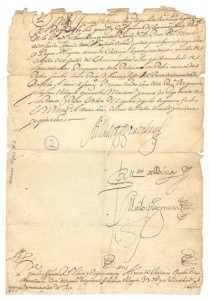In the course of my research at the Biblioteca Nacional de España this summer, I learned the hard way that without paleographical skills, many early modern and medieval texts become unreadable. Their interlinear and marginal glosses, not to mention major swathes of text, can be lost in the wake of illegibility. Leaving the hot, shimmering air of Madrid behind me everyday for the cool imperturbability of the library was simultaneously exhilarating and devastating. I often found myself able to transcribe some words that I could not read the day before and a sense of accomplishment would flow over me before being swept away by a new, incomprehensible blur of text.
Taking a paleography workshop this fall, hosted by Professor Kelly McDonough and organized by Juan Carlos de Orellana, I learned that paleography is a rich and complex field, with its necessary skills deriving from an artist’s intuition and from long hours spent practicing, debating, and developing a methodology. I quickly discovered that in my own case, and complementary to my own cramped writing style, the small, sharply-written, and highly abbreviated writing was more accessible—and legible—than the fluid, long scripts of some fifteenth and sixteenth century clerics. In those instances, a single word, full of flourishes and loops, seemed to consume an entire line of a letter. Whenever these texts appeared, I had to give up my turns transcribing, as I simply could not see the words as words on the paper. I learned to value how each reader perceives writing, and “valid” writing differently; at the same time the written word on the page speaks to the character and times of those writing.
Through my experiences, I learned a few tips and tricks to transcribing manuscripts:
1. Paleography requires time and patience; a word that is completely impenetrable one day becomes transparent the next.
2. Try reading the discernable letters of the unknown word out loud and experiment with sounds.
3. Always be aware of the context of the text, as it can reveal clues about your unknown word.
4. Trying to write the word yourself can reveal the orthographic tendencies of your writer and how a letter was formed.
5. When in doubt, ask someone else. They may be able to identify a word that you cannot.
6. Never stop practicing!
This blog post is part of our special series on paleography. See also the post «Esta firma es la original» and our feature article «Ophir de España: The Obstacles of Transcribing a Seventeenth-Century Colonial Manuscript«

